General election 2019: preview of the West Midlands
The 2019 general election presents voters with a complex task of choosing which party can best represent their Leave versus Remain view, as well as their policy preferences or left/right ideology. In the run-up to the 12 December polling day, the Democratic Audit team are previewing the elections in each of the UK’s regions in turn. The West Midlands is a pivotal region, where marginal seats have switched between the Conservatives and Labour in recent elections. Here we focus on the key seats identified from the results in 2017, latest polling, and how the Leave-Remain background affects the contest here.
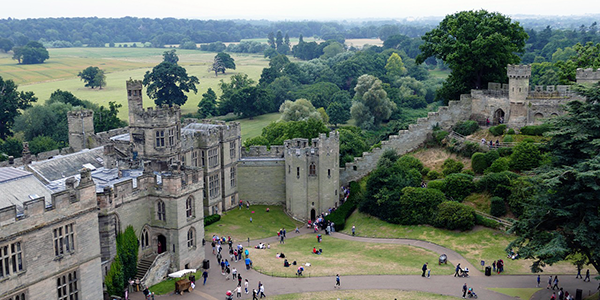
Warwick Castle. Picture: Pixabay/Public Domain
Bordering Wales to the west, and stretching to Rugby in the east, the West Midlands encompasses Birmingham (and the rest of West Midlands conurbation including Coventry, Dudley, Wolverhampton), Warwickshire, Staffordshire, Shropshire and Herefordshire and Worcestershire. Over successive Westminster elections, both West and East Midlands have been crucial for their Labour-Conservative marginal constituencies, with seats including Nuneaton, Dudley North, Newcastle-under-Lyme and Worcester all closely fought. In 2010 the balance tipped in favour of the Conservatives who overtook Labour as the largest party here in terms of seats and votes, a position they have maintained since (see Figures 1 and 2). This has come more sharply into focus since the 2016 referendum as the region’s Leave vote share was the highest in the country, at over 59%. UKIP and the Brexit Party have performed particularly well here in 2014 and 2019 European elections, respectively, polling top, though on current polling the Brexit Party’s presence is likely to be mildly disruptive in current Labour seats, rather than decisive, as the Conservatives consolidate the support of Leave-leaning voters.
Map showing the 2017 general election results in the West Midlands
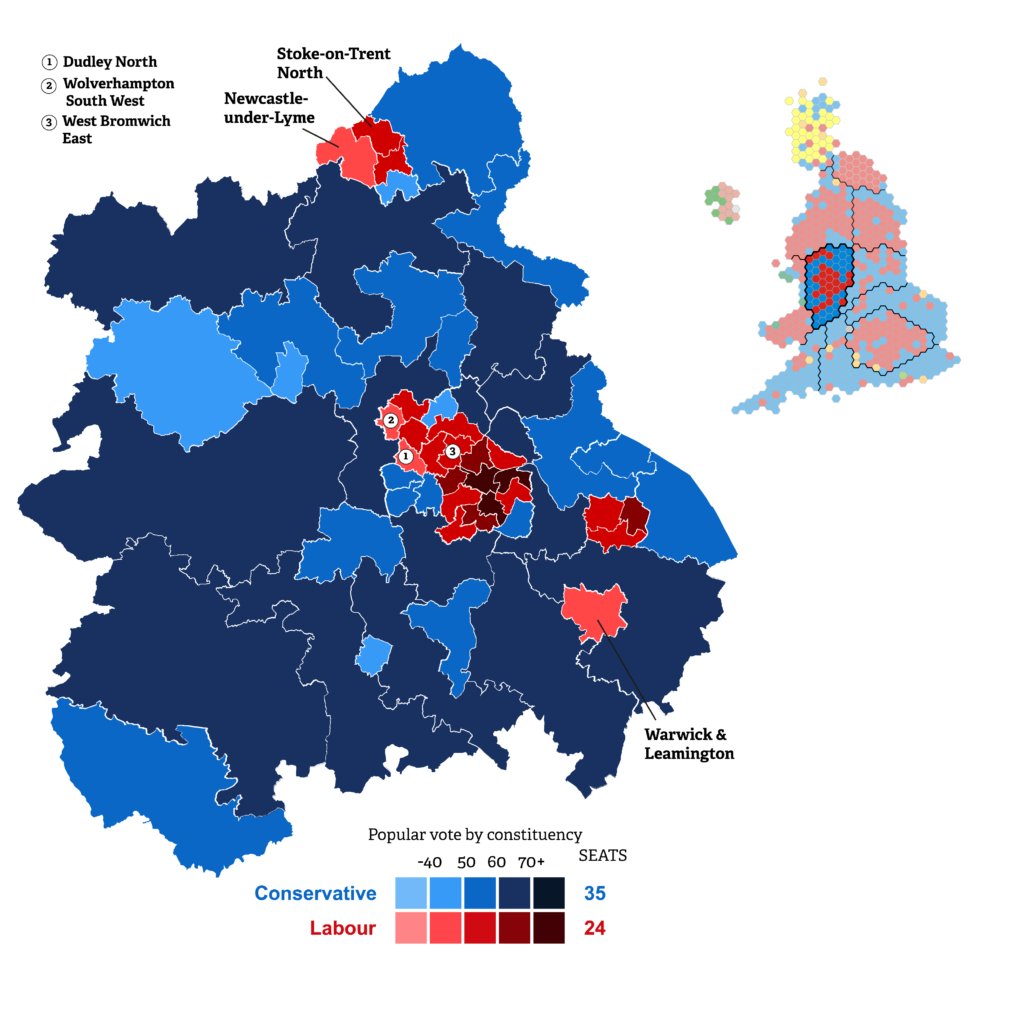
Source: Adapted from map by DrRandomFactor & Ch1902 /Wikipedia. Key constituency contests for 2019 labelled.
For all seats in the region, you can find full details of the candidates standing in 2019 and their social media links (so you can see what kind of a person they are and what issues they focus on) at DemocraticDashboard.com. It also gives complete results from the 2017 general election in each area, estimated 2016 EU referendum results and details about the constituency so you can best make up your own mind how to vote.
The estimated constituency results for all seats in the West Midlands in 2019, and regional vote shares given in figures 1 and 2, come from YouGov’s large MRP poll published on 27 November and are the best available at time of writing. A sample of 100,319 people was polled across the UK, and used, along with demographic and other data, to create estimates for each constituency.
Figure 1: Number of seats won by each party at the last three general elections in the West Midlands, and latest estimates from YouGov polling, 27 November
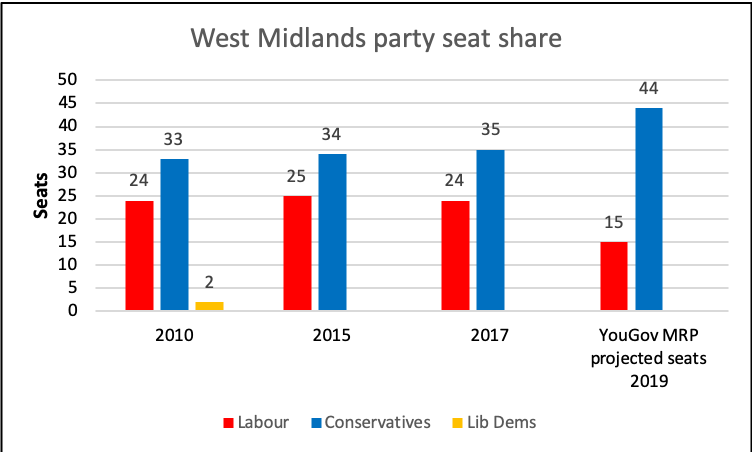
Note: 2019 figures from YouGov MRP seat estimates, 27 November, 2019.
Figure 2: Parties’ shares of the votes in the West Midlands at the last three general elections, and estimated vote share in 2019 (YouGov, 27 November)
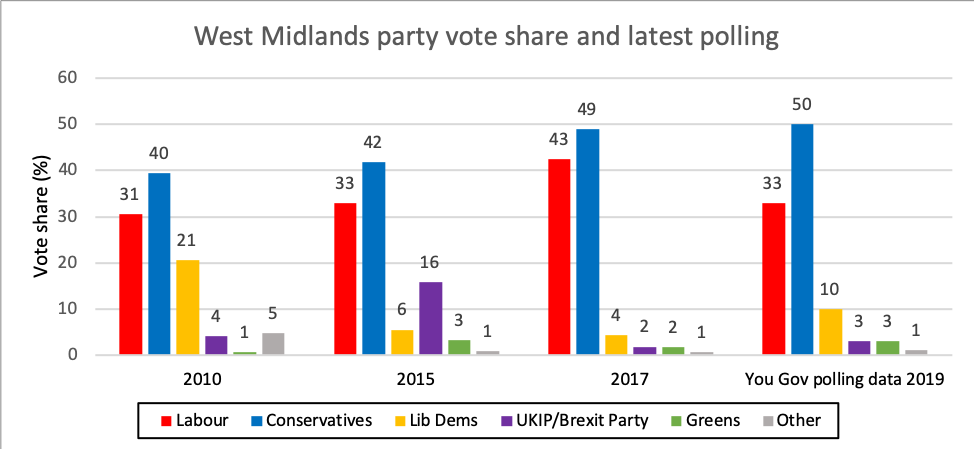
Note: 2019 data from Benjamin Lauderdale and Jack Blumenau for YouGov, 27 November.
Labour seats that are Conservative targets
Nine seats are forecast to switch from Labour to Conservative according to YouGov’s MRP model (see Figure 1). Dudley North and Newcastle-Under-Lyme are forecast to have a high probability of switching on small swings. Dudley North is already a Labour marginal, and has become further out of reach for them to retain given the local contest. It has been held by Labour since the seat was established in 1997, with Ian Austin serving as Labour MP since 2005. He left the party in early 2019 over Corbyn’s leadership, and has been strongly critical of its handling of anti-semitism cases. He has endorsed voting Conservative in this election. Brexit Party candidate Rupert Lowe withdrew just before nominations closed to aid the Conservative candidate. These two factors are likely to help the Conservatives win comfortably in this two-party race.
Newcastle-under-Lyme has been Labour since 1922, but has become increasingly marginal, with close races in 2010 (3.6% majority), 2015 (1.5% majority) and 2017 (just 30 votes in it). Unlike in Dudley North, there is a Brexit Party candidate standing here, and UKIP have previously polled well (third placed and 17% in 2015). Even so, it is equally an almost-certain Conservative gain at this election, who are banking on the 62% of voters here who voted Leave in 2016 (estimate) favouring them. Wolverhampton South West is the next most likely to switch. Here, as in similar seats in the region, the question, as posed by George Grylls in the New Statesman, is whether the Conservatives’ message on Brexit can convert anyone who does not already vote Tory. The seat voted 54% Leave, and last went Conservative in 2010, before switching back to Labour in 2015.
According to YouGov, a further five strongly Leave-leaning West Midlands seats are forecast to switch to the Conservatives, but do require a much higher swing and are vulnerable to small changes in the vote share or margin of error. They are: Stoke-On-Trent North (moving from a 6% Labour majority in 2017, to Conservatives 5% ahead), West Bromwich West, Wolverhampton North East, Stoke-On-Trent Central and West Bromwich East. It’s worth noting, though, that whereas Newcastle-under-Lyme is given a probability of turning Conservative of 94%, for Stoke-on-Trent Central it is just 53% – with an estimated result of 40% Conservative, 39% Labour with a strong 13% forecast for the Brexit Party, which the Conservatives will want to squeeze.
Given by YouGov a probability of a Conservative gain of 57% is West Bromwich East, Labour Deputy Leader Tom Watson’s former seat (he is standing down). The estimated vote share indicates a narrow result: 40% Conservative to 39% Labour, with 8% Brexit Party and 6% Lib Dem. This is, along with Leigh in the Northwest, the seat YouGov’s poll indicates might see the largest swing from Labour, overturning a Labour majority of near 20% (the result though is effectively a toss-up on current polling, and really too close to call). There is a Brexit party candidate standing here, and the vote may also be further fragmented since former Labour and former Respect party MP, George Galloway, is also standing here, on a Left-Brexit platform.
The picture is different in Warwick and Leamington, where the Labour Party is again defending a slim majority of 2.2%, but in this case the seat leans Remain (58%) and the Lib Dem vote share could determine whether they hold on. According to YouGov the Lib Dems are up on 2017, with a 12% vote in the constituency estimated. This somewhat mirrors the 2010 results here, where a three-way party contest saw the Conservatives take it from Labour (who regained it in 2017). As such, all Remain-focused tactical voting sites advocate voting Labour, and polling for the Economist suggests constituents’ tactical votes may be crucial in this seat. The Brexit Party is also standing here.
If there were a slightly higher swing to the Conservatives than current YouGov polling indicates, three more Labour seats become vulnerable: Birmingham, Northfield; Coventry North West, and Coventry South.
Conservative seats that could be vulnerable
Though both Telford and Stoke-on-Trent South are a couple of the most marginal seats in the region (see Figure 3), with the Conservatives defending majorities of just 1.6%, on current polling they are safe. Stoke-on-Trent South was one of the Conservatives’ gains in 2017, with them having progressively gained ground on Labour in recent elections, but on YouGov’s current polling, Labour have little chance of regaining it. This highlights the Conservatives’ ability to focus on seat gains over defence in the Midlands.
Remain party challengers
In a region where most seats likely to switch hands are Leave-leaning, the smaller Remain parties will have less impact – with the possible exception of Warwick and Leamington, discussed above. There is just one ‘Unite to Remain’ seat in the region, Cannock Chase, where the Lib Dems are standing aside in favour of the Greens. Given both parties achieved just 1.7% of the vote each in the seat and the Conservatives have a 17.5% majority, it is unlikely to make much difference here.
For the Liberal Democrats, the two seats they held back in 2010, Solihull and Birmingham Yardley, are now firmly out of their targets, having gone progressively safer Conservative and Labour respectively over subsequent elections.
Figure 3: The West Midlands’ most marginal seats (by % vote) from the 2017 election
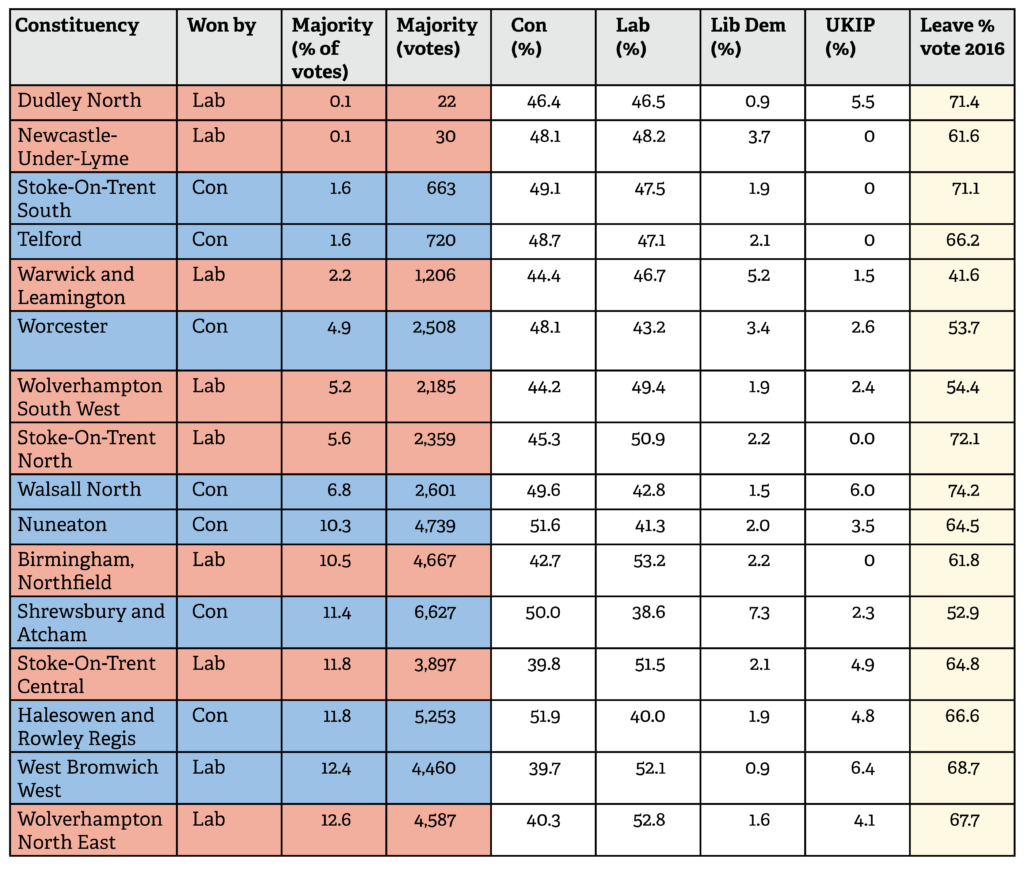
Note: The Leave % for each the 2016 Brexit referendum by constituency (and mentioned throughout this article), are Chris Hanretty’s estimates. You can also find these for each constituency (including those we don’t discuss), along with general election results at DemocraticDashboard.com.





 Democratic Audit's core funding is provided by the Joseph Rowntree Charitable Trust. Additional funding is provided by the London School of Economics.
Democratic Audit's core funding is provided by the Joseph Rowntree Charitable Trust. Additional funding is provided by the London School of Economics.